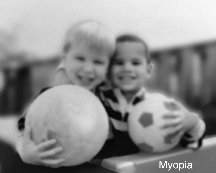The prevalence of myopia (or "shortsightedness") is about 30 to 40 percent in the United States and Europe but reaches 70 to 90 percent in some Asian populations, and rates are rising in all ethnic groups. Treatment costs in the United States are estimated at $250 million annually. A review by Fredrick emphasizes the importance of early influences on eye function and addresses the possibility that prolonged reading may contribute to the development of myopia.
Myopia occurs when an image is focused in front of the retina, either because of excessive curvature of the cornea or lens or because the eye itself is too long. The refractive error in mild cases of myopia is zero to -1.5 diopters (D), whereas in moderate myopia it ranges from -1.5 D to -6.0 D. High myopia is defined as errors greater than -6.0 D. Pathologic myopia, in which the patient has a refractive error of more than -8.0 D, occurs in about 1 to 3 percent of the population and is associated with potentially blinding conditions such as retinal detachment, macular degeneration, and glaucoma.
At birth, most infants are hyperopic, meaning images are focused behind the retina. Growth gradually results in normalization (emmetropia) by five to eight years of age. Studies of the development of myopia have been complicated by problems of randomization, follow-up, and confounding factors in children and families. Twin and family studies support significant genetic contributions to the development of myopia, especially the more severe forms. Autosomal-dominant predispositions have been established for some pathologic forms. Myopia cannot be directly correlated with intelligence because of confounding variables.
Epidemiologic studies support the "old wives' tale" that prolonged reading or close work leads to myopia. Myopic persons who frequently engage in these activities develop progressively worse vision through the third decade of life. The suggested model of myopia development (see the accompanying figure) postulates that in normal childhood development, the process of eye growth is related to the correct focusing of the image on the retina.
In myopia, the growth process continues after correction of the initial hyperopia. Myopiogenic factors, such as prolonged reading or close work, produce blurred retinal images that trigger a biochemical process in the retina, stimulating structural changes in the sclera and choroid that lead to axial elongation. Therefore, the development of myopia can continue in a predisposed person beyond the teenage years.
Although most myopic children stabilize at low to moderate levels, those with strong genetic risk factors and rapid progression of myopia are at risk of developing high myopia. Most interventions focus on decreasing the accommodative requirements of the eyes, but many have not been rigorously studied. Anticholinergics in combination with bifocals can slow the progression of myopia, but the long-term effect appears to be limited to only a 1- to 2-D gain. Clinical trials of modulators of scleral growth are underway. Rigid or gas-permeable contact lenses appear to slow the development of axial myopia to a greater extent than bifocals, but the reason is unknown. Laser surgery can correct refractive errors but does not reduce the rate of retinal detachment, macular degeneration, and glaucoma.
The author recommends identifying children with risk factors for myopia and accurately correcting refractive errors, because overcorrection can make myopia worse. A "healthy balance" of physical activity and reading (in adequate light) is recommended. He also encourages participation in ongoing clinical trials and provides Web sites for three trials sponsored by the National Institutes of Health.
EDITOR'S NOTE: Is this another reason for mothers to feel guilty about encouraging their children to read, or an incentive for the screening of young children to detect those with myopia in time for corrective action? Does excessive reading enhance myopia, or does the child with imperfect vision select reading instead of more athletic pastimes? As children increasingly prefer the computer screen to the book, what will happen to the rising trend of myopia? Who would have thought myopia could be so interesting?--A.D.W.
COPYRIGHT 2002 American Academy of Family Physicians
COPYRIGHT 2002 Gale Group



